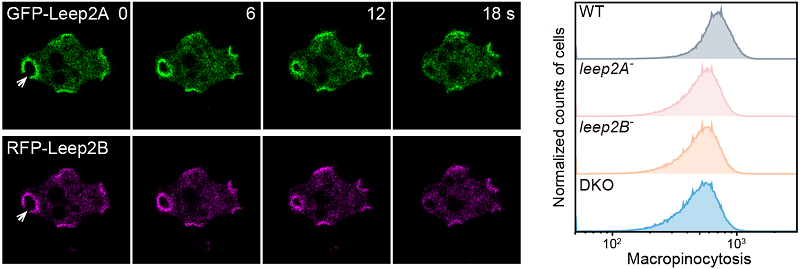Research reveals how cells form macropinocytic structures
Macropinocytosis mediates the non-selective bulk uptake of extracellular fluid, enabling cells to survey the environment and acquire nutrients. In the social amoeba Dictyostelium discoideum, macropinocytosis facilitates the uptake of nutrients, including amino acids and glucose. In mammals, it plays an important role in immune surveillance and synaptic activity regulation. Macropinocytosis is hijacked by pathogens to invade cells and is exploited by cancer cells to promote their growth and proliferation by scavenging extracellular proteins and fatty acids.
A conserved set of signaling proteins orchestrates the actin dynamics that lead to membrane ruffling and macropinosome formation across various eukaryotic organisms. At the center of this signaling network are Ras GTPases, whose activation potently stimulates macropinocytosis. However, how Ras signaling is initiated and spatiotemporally regulated during macropinocytosis are not well understood.
On June 18, 2024, a research group led by Prof. CAI Huaqing at the Institute of Biophysics, Chinese Academy of Sciences published a research paper in Journal of Cell Biology. By using Dictyostelium as the model system and a proteomics-based approach to identify regulators of macropinocytosis, the researchers uncovered Leep2, consisting of Leep2A and Leep2B, as a RasGAP complex. The Leep2 complex specifically localizes to emerging macropinocytic cups and nascent macropinosomes, where it modulates macropinosome formation by regulating the activities of three Ras family small GTPases. Deletion or overexpression of the complex, as well as disruption or sustained activation of the target Ras GTPases, impairs macropinocytic activity.
This study reveals the critical role of fine-tuning Ras activity in directing macropinosome formation. The Ras gene also serves as a central regulatory element in macropinocytosis in mammalian cells and is frequently mutated in tumors. Thus, this study lays the foundation for future investigations into how Ras-centered signaling pathways regulate macropinocytosis in tumor cells.

Fig1. The Leep2A/2B RasGAP complex localizes to macropinocytic cups and regulate the cells' macropinocytic activity
(Image by CAI Huaqing's group)
Article link: https://doi.org/10.1083/jcb.202401110
Contact: CAI Huaqing
Institute of Biophysics, Chinese Academy of Sciences
Beijing 100101, China
E-mail: huaqingcai@ibp.ac.cn
(Reported by Prof. CAI Huaqing's group)

